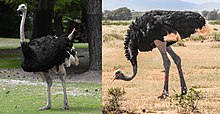
Back نعامة Arabic Waikoy (Struthio) AVK Dəvəquşu Azerbaijani Ostrich BCL Struthio Catalan Struthio CEB وشترمەل CKB Pštros Czech Struthio Spanish Jaanalind (perekond) Estonian
| Ostrich | |
|---|---|

| |
| Montage of two living species, from left to right: common ostrich and Somali ostrich | |
| Scientific classification | |
| Domain: | Eukaryota |
| Kingdom: | Animalia |
| Phylum: | Chordata |
| Class: | Aves |
| Infraclass: | Palaeognathae |
| Order: | Struthioniformes |
| Family: | Struthionidae |
| Genus: | Struthio Linnaeus, 1758[1] |
| Type species | |
| Struthio camelus Linnaeus, 1758
| |
| Species | |
| |
| Synonyms | |
| |
Ostriches are large flightless birds. Two living species are recognised, the common ostrich, native to large areas of sub-Saharan Africa, and the Somali ostrich, native to the Horn of Africa.
They are the heaviest and largest living birds, with adult common ostriches weighing anywhere between 63.5 and 145 kilograms and laying the largest eggs of any living land animal.[3] With the ability to run at 70 km/h (43.5 mph),[4] they are the fastest birds on land. They are farmed worldwide, with significant industries in the Philippines and in Namibia. South Africa produces about 70% of global ostrich products,[5] with the industry largely centered around the town of Oudtshoorn. Ostrich leather is a lucrative commodity, and the large feathers are used as plumes for the decoration of ceremonial headgear. Ostrich eggs and meat have been used by humans for millennia. Ostrich oil is another product that is made using ostrich fat.
Ostriches are of the genus Struthio in the order Struthioniformes, part of the infra-class Palaeognathae, a diverse group of flightless birds also known as ratites that includes the emus, rheas, cassowaries, kiwis and the extinct elephant birds and moas.
The common ostrich was historically native to the Arabian Peninsula, and ostriches were present across Asia as far east as China and Mongolia during the Late Pleistocene and possibly into the Holocene.
- ^ Gray, George Robert (1855). Catalogue of the Genera and Subgenera of Birds contained in the British Museum. London, UK: Taylor and Francis. p. 109.
- ^ BirdLife International (2018). "Struthio camelus". IUCN Red List of Threatened Species. 2018: e.T45020636A132189458. doi:10.2305/IUCN.UK.2018-2.RLTS.T45020636A132189458.en. Retrieved 29 February 2024.
- ^ Del Hoyo, Josep, et al. Handbook of the birds of the world. Vol. 1. No. 8. Barcelona: Lynx edicions, 1992.
- ^ Doherty, James G. (March 1974). "Speed of animals". Natural History.
- ^ Western Cape Department of Agriculture (July 2020). "The South African Ostrich Industry Footprint" (PDF). Retrieved 20 May 2024.
